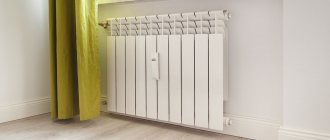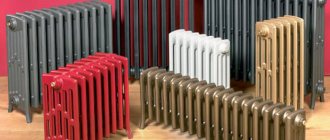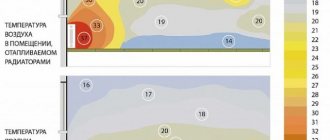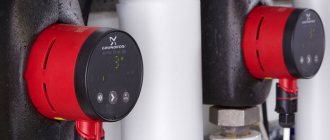Calculation of different types of radiators
If you are going to install sectional radiators of a standard size (with an axial distance of 50 cm in height) and have already chosen the material, model and desired size, there should not be any difficulties in calculating their number. Most reputable companies that supply good heating equipment have on their website the technical data of all modifications, including thermal power. If it is not the power that is indicated, but the coolant flow rate, then it is easy to convert to power: the coolant flow rate of 1 l/min is approximately equal to the power of 1 kW (1000 W).
The axial distance of the radiator is determined by the height between the centers of the holes for coolant supply/discharge
To make life easier for customers, many websites install a specially designed calculator program. Then the calculation of heating radiator sections comes down to entering data on your premises in the appropriate fields. And at the output you have the finished result: the number of sections of this model in pieces.
The axial distance is determined between the centers of the coolant holes
But if you’re just evaluating possible options, then it’s worth considering that radiators of the same size made of different materials have different thermal power. The method for calculating the number of sections of bimetallic radiators is no different from calculating aluminum, steel or cast iron. Only the thermal power of one section can be different.
To make it easier to calculate, there are averaged data that you can use as a guide. For one radiator section with an axial distance of 50 cm, the following power values are accepted:
- aluminum - 190W
- bimetallic - 185W
- cast iron - 145W.
If you are just figuring out which material to choose, you can use this data. For clarity, we present the simplest calculation of sections of bimetallic heating radiators, which takes into account only the area of the room.
When determining the number of heating devices made of bimetal of a standard size (center distance 50 cm), it is assumed that one section can heat 1.8 m 2 of area. Then for a room of 16 m 2 you need: 16 m 2 /1.8 m 2 = 8.88 pcs. Let's round up - we need 9 sections.
We calculate similarly for cast iron or steel bars. All you need is the following rules:
- bimetallic radiator - 1.8m2
- aluminum - 1.9-2.0 m 2
- cast iron - 1.4-1.5 m 2.
This data is for sections with an interaxial distance of 50 cm. Today, there are models on sale with very different heights: from 60cm to 20cm and even lower. Models 20cm and below are called curb. Naturally, their power differs from the specified standard, and if you plan to use a “non-standard”, you will have to make adjustments. Either look for passport data, or do the math yourself. We proceed from the fact that the heat transfer of a heating device directly depends on its area. As the height decreases, the area of the device decreases, and, therefore, the power decreases proportionally. That is, you need to find the ratio of the heights of the selected radiator with the standard, and then use this coefficient to correct the result.
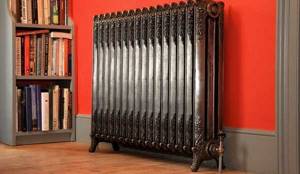
Calculation of cast iron heating radiators. Can be calculated by area or volume of the room
For clarity, we will calculate aluminum radiators by area. The room is the same: 16m 2. We count the number of sections of standard size: 16m 2 /2m 2 = 8 pieces. But we want to use small sections with a height of 40 cm. We find the ratio of radiators of the selected size to standard ones: 50cm/40cm=1.25. And now we adjust the quantity: 8pcs * 1.25 = 10pcs.
Features of operation
Heaters powered by bottled gas can differ according to numerous criteria
It is necessary to pay attention to the characteristics of the equipment, which will allow you to choose the right heater for the characteristics of a particular building and private home.
Main characteristics:
- Availability of automatic control.
- Type of convention.
- Presence or absence of a fan.
- Energy carrier used.
- Combustion chamber type.
- Installation power.
- Heat exchanger material.
Depending on the design, such heaters can be installed on the floor or mounted on the wall. Wall-mounted models are highly efficient and light weight. The power of wall-mounted liquefied gas convector heaters can reach 10 kW, which allows them to heat large rooms. Floor-standing units can be equipped with a larger heat exchanger, but their performance usually does not exceed 5 kW.
When running a propane boiler is already dangerous:
Combustion chamber type
The combustion chamber can be closed or open. In recent years, models with a closed combustion chamber have become the most popular, which ensures the highest possible efficiency and complete safety of equipment operation. Convectors with a closed combustion chamber can have a coaxial pipe instead of a classic chimney, which simultaneously takes in fresh air from the street and effectively removes combustion products outside. The only drawback of convectors with a closed burner is their high cost.
Heat exchanger material
The material from which the heat exchanger is made will directly affect the durability, efficiency and reliability of the equipment. Today on the market there are convectors with heat exchangers made of cast iron and steel. The most durable, reliable and durable devices are those made with a cast iron heat exchanger. If used properly, they will last for 50 years. The disadvantage is the high cost of models with cast iron heat exchangers.
Some convector models will last you longer than others
Convection type
Depending on their type, thermal installations can use forced and natural convention. Heaters operating with natural convection make virtually no noise, which allows them to be used in residential areas. The advantage of devices with forced convection is their improved performance and the ability to use such equipment to heat large areas. Fuel consumption in a bottled gas convector can vary significantly depending on the power of the equipment and its type of convection.
Control automation
The gas convectors we offer can be equipped with both simple automation, which includes only thermostats and control relays, and advanced logic, which ensures maximum automation of equipment operation. Depending on the automation used, the cost of heating installations will differ.
Correct power calculation
The universal formula for calculating power is 1 kW of thermal energy per 10 square meters of room area. However, such calculations will be averaged and will not always allow you to choose the right converter for a specific room. It is necessary to take into account the structural features, ceiling height, the presence or absence of windows, high-quality wall insulation, as well as the climate in the region.
When choosing a convector, you need to calculate its power
When choosing fully automated installations that have a forced convention, you can proceed from the calculation of 0.7 kW of thermal energy per 10 square meters of room area. They can be used as the main heating method only in small buildings. A propane gas convector is an ideal solution for a wooden or brick cottage.
Example
To help you understand everything, let's give a small example. For example, we need a convector to heat 10 m², there is a window and a ceiling (4 m²). Applying these indicators in our formula, we get:
40x4x10 = 1.6 kilowatts
In this case, the maximum power for such a room will be 2 kilowatts.
Note! We also note that the convector should be placed directly under the window so that the cool air coming from the street is immediately heated and does not lead to a decrease in the temperature in the room.
Now let’s talk about the case if the convector was installed as an auxiliary heating source. Here, instead of 40, you need to insert 25-35 watts, depending on the volume of the room. The larger the room, the higher the indicator should be used. Let’s say our area is 20 m², and the ceiling height is 3 m. Let’s do simple calculations:
3x20x25 = 1.5 kilowatts
If a value of 35 watts were used, the required power would be 1 kilowatt. We take the average figure - it is 1.25 kilowatts.
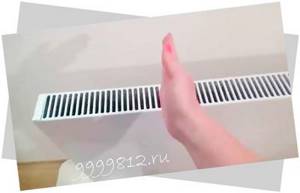
The most accurate calculation of the heater power can only be performed by a professional, taking into account all the inputs, including the climate zone and building material, and the quality of the house insulation. There are really a lot of parameters, so what should a simple consumer who is standing at the counter with convectors do?
Types of convectors by installation method
Wall-mounted appliances have more power compared to other appliances. They do not take up floor space, so they are easy to use. The disadvantages of this placement option include the fact that warm air does not fall down, but tends to the ceiling, and the floor remains cold.
Floor-standing types of appliances, although they are produced with less power, but due to their location near the floor surface, heat the room much faster. Convenient is the ability to move to different points, which cannot be done with a permanently mounted electric wall convector.
The installation of small-sized electric heating devices in floor niches significantly saves space in small rooms. In recent years, such placement has been very popular, although it requires preliminary work.
Skirting types of convectors have received positive reviews. which give a feeling of comfort to the feet. Their power is small, but to increase the flow of warm air, some users buy two or more devices, which equates to the energy consumption of a large device.
Different types of thermostats
The temperature regulator is adjusted so that if there are no residents in the house, the room is heated in a gentle mode and does not require unnecessary consumption of electrical energy. By time, you can set a mode when the switching on occurs automatically with the return of household members.
Temperature regulators can be mechanical or electronic. The first type significantly reduces the price of the device, but is not very convenient in terms of comfort. It cannot fully monitor the temperature regime; sometimes it allows, albeit minimal, additional waste of electricity.
In addition, switching is accompanied by quiet sounds, which at night can cause trouble for a sleeping person.
What is convection and convector
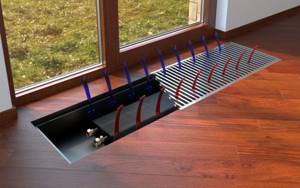
Convection is the movement of air masses due to differences in densities (and, accordingly, masses). Cold air entering the room moves downwards. Heating devices are concentrated in the lower sector of the premises - the air heats up, passing through the structures of convectors (radiators), acquires less density and mass, and rises. In this way, the process of convective heat exchange occurs. Its benefit is that there is no power to move air; everything happens naturally.
Main advantages of convectors:
- No hot surfaces;
- Possibility of working on electricity (in the absence of other energy sources);
- Attractive appearance;
- Embedding in building structures - floors, plinths - allows you to save space;
- Convectors have a mobile version (movable);
- High-quality control - remote, programmable, and so on.
A convector is a heating device that operates using the principle of convective heat exchange. The device has a simple design and consists of the following main parts:
- Metal casing with protective grille and air inlet holes;
- Heating component – electric, water or gas;
- Control system.
The air enters the casing through special openings, heats up and leaves the convector through the protective grille. To increase thermal power, some types of convectors are equipped with built-in fans that increase the air flow. Such convectors are superior to radiators in terms of operating efficiency.
Based on the installation method, there are floor-mounted, wall-mounted and built-in convectors. Built-in convectors are installed in the floor and in the baseboard sector of the room. Depending on the type of energy carrier used, there are three types of convective heaters:
- Water heating convectors;
- Electric heating convectors;
- Gas convectors.
Water convectors use a tubular finned heat exchanger as a heating element, through which the coolant moves, giving off heat to the heated air. The heat exchanger is most often made of copper, which is neutral to the influence of external negative factors - corrosion, low quality coolant, and so on. Due to the fins, the heat transfer area increases.
The same principle is implemented in electric and gas convectors; they differ only in the design of the heating element. Electric convectors use needle, heating element and heaters built into a monolithic complex; gas convectors use a burner and a heat exchanger. Each type of convector has its own characteristics.
Water is considered the best option, but requires the installation of supply pipelines. Using water coolant is the most economical option among competitors. An electric convector is easy to install and operate, but the electrical power consumed by the convector significantly increases the amount of energy costs. A gas appliance requires compliance with the rules for the operation of devices operating on natural gas and connection to the gas pipeline.
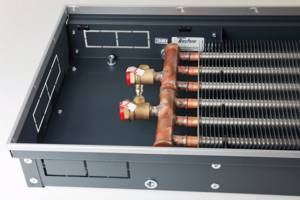
Convector design
Calculation of the required convector power
Professional methods are used for detailed calculation of thermal power. They are based on calculating the amount of heat loss through the enclosing structures and correspondingly compensating them with thermal heating power. The methods are implemented both manually and in software format.
To calculate the thermal power of convectors, an integrated calculation method is also used (if you do not want to contact designers). The power of convectors can be calculated by the size of the heated area and the volume of the room.
The generalized standard for heating a built-in room with one external wall, a ceiling height of up to 2.7 meters and a single glazed window is 100 W of heat per square meter of heated area.
In the case of a corner location of the room and the presence of two external walls, a correction factor of 1.1 is applied, increasing the calculated thermal power by 10%. With high-quality thermal insulation, triple window glazing, the calculated power is multiplied by a factor of 0.8.
Thus, the calculation of the thermal power of the convector is calculated based on the area of the room - to heat a room with an area of 20 sq.m. with standard heat loss indicators, you will need a device with a power of at least 2.0 kW. With a corner location of this room, the power will be from 2.2 kW. In a well-insulated room of equal area, you can install a convector with a power of about 1.6 - 1.7 kW. These calculations are correct for rooms with a ceiling height of up to 2.7 meters.
For rooms with higher ceiling heights, the volume calculation method is used. The volume of the room is calculated (the product of the area and the height of the room), the calculated value is multiplied by a factor of 0.04. When multiplied, the heating thermal power is obtained.
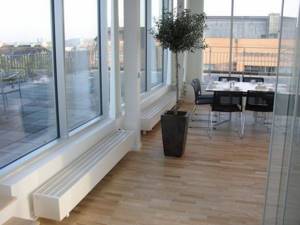
Using convectors in large rooms
Using this method, a room with an area of 20 square meters and a height of 2.7 meters requires 2.16 kW of heat for heating, the same room with a ceiling height of three meters requires 2.4 kW. With large volumes of premises and significant ceiling heights, the calculated capacity by area can increase up to 30%.
Calculation of convector power by volume
You already know how to calculate the power of a convector, taking into account the area of the premises. But some experts believe that it is best to calculate by their volume. To do this, use the formula according to which per 1 cubic meter. m. volume requires 40 W of heat
. The main advantage of this formula is that it is the most accurate, since it fully takes into account the height of the ceilings.
The process of calculating the power of convectors by volume is carried out as follows:
- We take a tape measure and measure the room;
- We calculate the volume of the room by multiplying the obtained values by each other;
- Multiply the volume by 0.04 (40 W per 1 cubic meter);
- We get the recommended thermal power.
A more clear example - let's try to calculate the power of convectors for a room 3 m long, 2.5 m wide and 2.7 m high. Its volume is 20.25 cubic meters. m, therefore, the power of the convector heaters used should be 0.81 kW (feel free to buy a 1 kW model). If we make similar calculations for the area, the recommended figure will be 0.75 kW.
As in the case of calculating the power of convectors by area, it is necessary to take into account in the calculations possible heat losses that may be present in any room.

Our houses lose a lot of thermal energy. In order not to overpay for electricity, just get rid of heat loss.
By making calculations based on area or volume, and not taking heat losses into account at all, you risk getting an insufficiently efficient heating system - the rooms will be cool. The worst thing is if severe frosts hit in winter, which are not very typical for this area - if the calculations were made incorrectly, the convectors will not cope
Next, we will tell you how to reduce heat loss. The banal lining of the household with an additional layer of brick and thermal insulation will help reduce them by 10-15%. Yes, the costs may be high, but you must remember that when using electric convectors, the costs of light can be gigantic - this is associated with large heat losses (in fact, you are heating the air “outside”).
You also need to work on the windows:
- Single-glazed windows require a 10% increase in power;
- Double windows do not lead to any heat loss (already a plus);
- Triple windows can save up to 10%.
In theory, three-pane windows can lead to significant savings, but there are other factors to consider.
During the insulation process, it is necessary to work in the attic. The whole point is that having an unheated attic entails losses. Therefore, you need to lay a layer of effective thermal insulation on it - it is not very expensive, but you can save up to 10% of thermal energy. By the way, the figure is 10%, based on the area of the house of 100 square meters. m, this is approximately 24 kW of heat per day - equivalent to monetary costs of 100 rubles / day or 3000 rubles / month (approximately).
Auxiliary heating calculation
If the house already has centralized heating, then no convectors are needed here. But if the heating system works very poorly, you should take action - we use convector heaters as auxiliary equipment. It will be very easy to calculate the required power - it is equal to half the power of full heating. For example, for an apartment of 100 square meters. m. 5 kW convectors will be required.
In a similar way, you can calculate by volume - count the convectors for the entire area based on the formula 20 W per 1 cubic meter. m.
Climate zones are also important
Climatic zones also have their own coefficients:
- central Russia has a coefficient of 1.00, so it is not used;
- northern and eastern regions: 1.6;
- southern stripes: 0.7-0.9 (minimum and average annual temperatures in the region are taken into account).
This coefficient must be multiplied by the total thermal power, and the resulting result divided by the heat transfer of one part.
conclusions
Thus, calculating heating by area does not present any particular difficulties. It’s enough to sit a little, figure it out and calmly calculate. With its help, every owner of an apartment or house can easily determine the size of the radiator that should be installed in the room, kitchen, bathroom or any other place.
If you doubt your abilities and knowledge, entrust the installation of the system to professionals. It’s better to pay professionals once than to do it wrong, dismantle it and start work again. Or do nothing at all.
Choosing an installation location
Or rather, the question is not this: which convector is suitable for fulfilling your wishes. If you want to bring the appearance of the room closer to the standard one, you can hang rectangular wall convectors under the windows. Models that can be installed under the ceiling attract a little more attention, but they are inaccessible to children and pets - they will not be able to get burned or “adjust” in their own way. The installation method is the same here - on brackets fixed to the wall. Only the shape of the brackets differs.
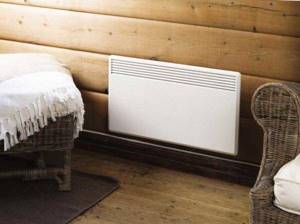
You can choose any location for installing the electric convector. It is only advisable that it is not covered by furniture
If you want your heating appliances not to be visible, you will have to choose between baseboard and in-floor models. There is a big difference in installation: skirting boards are simply installed and connected to the network, but for in-floor ones you will have to make special recesses in the floor - their top panel should be on the same level as the finished floor. In general, you cannot install them without major repairs.
These are floor-mounted convectors. They are also electric
heating elements
Next you should pay attention to the heating elements. Needle-type heating elements, where the spiral is not protected by anything and is fixed on a thin plate, are very fragile; a small blow to the body is enough for the spiral thread to break.
But such convectors are much cheaper than with other types of heaters.
The most reliable and durable are monolithic heating elements. They are not afraid of shocks and can even withstand the device being tipped over. However, the cost of devices with heating elements is much higher.
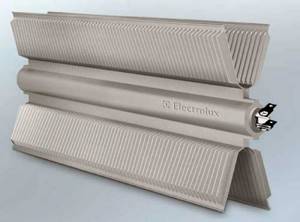
The choice of monolithic heating elements is also supported by the operation of the convector itself.
Needle-type heaters may crackle slightly during operation, while monolithic heaters are absolutely silent.
Calculations of electricity consumption by household appliances
Before finding out how much electricity a heater consumes, let’s consider the consumption of other household appliances. All devices that require electrical energy to operate consume this energy in accordance with their power. However, not all such devices operate in the same way and, accordingly, electricity consumption is not the same. Appliances such as an electric kettle, TV, and various types of lighting fixtures begin to consume the maximum amount of energy when turned on. This amount of energy is indicated in the technical characteristics of each device and is called power.
Let's say a kettle with a power of 2000 W was turned on to heat water and worked for 10 minutes. Then we divide 2000 W by 60 minutes (1 hour) and it turns out 33.33 W - this is how much the kettle consumes in one minute of operation. In our case, the kettle worked for 10 minutes. Then we multiply 33.33 W by 10 minutes and get the power that the kettle consumed during its operation, i.e. 333.3 W and it is for this consumed power that you will have to pay.
The operation of a refrigerator, electric stove and electric convector works somewhat differently.
How can you save money?
It is, of course, unreasonable to completely abandon the benefits of modern life, but in order to save money, you can pay attention to energy-saving refrigerators, because this device will work all year round, regardless of weather conditions. If you calculate how much energy a TV and computer consume per month, you can completely influence this amount by choosing one working device
Often, a switched-on monitor works all day without any benefit, and a running TV becomes the background against which we carry out everyday activities. Getting rid of such habits is not easy, but within a month it will give results in the form of a reduced energy bill.

Other methods to save electricity:
Replace all lighting fixtures with new energy-saving or LED lamps. The initial investment will pay off handsomely with serious savings and a long service life. If you use an electric kettle frequently, always add only as much water as needed, and not in reserve. Unfortunately, energy-saving kettles have not yet been invented, but it is entirely within your power to adjust the mode of use. Place your computer in comfortable standby mode. In this case, it turns off automatically if a certain amount of time passes without operation.
When turned on, it will accordingly consume less energy, which is also important. Defrosting the refrigerator and freezer on time is also part of family savings. When a significant amount of ice forms on the walls, energy consumption increases, so be sure to eliminate this factor. The use of heat-reflecting screens will help make heaters and convectors work more efficiently. Replacing wiring and organizing local lighting in the kitchen or recreation area will also significantly reduce costs. The use of adapters and extension cords increases energy consumption. When purchasing new electrical appliances, it is better to give preference to the economical consumption class
The main positions are shown in the table.
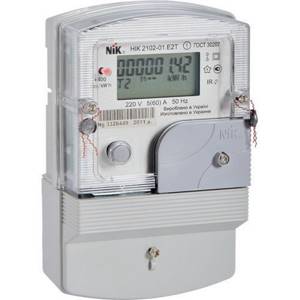
One of the less common ways to save electricity is the installation of multi-tariff meters. This will allow you to turn on some appliances at night, when electricity costs less. This practice has shown itself to be excellent in foreign countries, but unfortunately, it has not yet taken root here.
It is probably impossible to completely abandon the use of electrical appliances in the modern world. Even a gas boiler and heating convector must consume a certain amount of energy to function. If we are talking about a welding machine, boiler or air conditioner, the consumption is significant even with short-term use. Despite this, consumers are buying more and more different electrical appliances, so it would be useful to find out the main “culprit” of electricity bills, as well as proven methods of reasonable savings that will help reduce costs.
Heating convector power table
This section of the article provides a table for selecting the power of convectors depending on the area of the heated room and volume.
| Heated area, sq.m., room height – up to 2.7 meters | Convector thermal power, kW | Thermal power of the convector (ceiling height -2.8 m) | Thermal power of the convector (ceiling height -2.9 m) | Thermal power of the convector (ceiling height -3.0 m) |
| 1 | 2 | 3 | 4 | 6 |
| 10 | 1,0 | 1,12 | 1,16 | 1,2 |
| 15 | 1,5 | 1,68 | 1,74 | 1,8 |
| 20 | 2,0 | 2,24 | 2,32 | 2,4 |
| 25 | 2,5 | 2,8 | 2,9 | 3 |
| 30 | 3,0 | 3,36 | 3,48 | 3,6 |
From the table below you can select a convector according to the heated area. Heights are given in 4 options - standard (up to 2.7 meters), 2.8, 2.9 and 3.0 meters. For angular configurations of premises, an increasing factor of 1.1 must be applied to the selected value; for construction with high-quality thermal insulation, a decreasing factor of 0.8 must be applied. If the ceiling height is more than three meters, the calculation is carried out using the above method (by volume using a coefficient of 0.04).
After calculating the thermal power, heating convectors are selected - quantity, geometric dimensions and installation method. When selecting devices in rooms of large area and volume, it is necessary to take into account the characteristics and power value of each individual convector. It is necessary to be guided by the principle of increased power of the convector installed in the blockage zone of maximum heat losses. That is, a device installed along a full-profile glass display case should have a higher thermal performance value than a convector placed near a small window or an external wall.
Summary table of units of measurement
| Physical quantity | Non-systemic unit | SI unit | Transition from a non-systemic unit to an SI unit |
| Activity of a nuclide in a radioactive source | Curie (Ci) | Becquerel (Bq) | 1 Ci = 3.7⋅1010 Bq |
| Exposure dose | X-ray (R) | Coulomb/kilogram (C/kg) | 1 P = 2.58⋅10−4 C/kg |
| Absorbed dose | Glad (glad) | Gray (J/kg) | 1 rad = 0.01 Gy |
| Equivalent dose | rem (rem) | Sievert (Sv) | 1 rem = 0.01 Sv |
| Exposure dose rate | Roentgen/second (R/s) | Coulomb/kilogram (in) second (C/kg s) | 1 R/s = 2.58⋅10−4 C/kg s |
| Absorbed dose rate | Rad/second (Rad/s) | Gray/second (Gy/s) | 1 rad/s = 0.01 Gy/s |
| Equivalent dose rate | rem/second (rem/s) | Sievert/second (Sv/s) | 1 rem/s = 0.01 Sv/s |
| Integral dose | Rad-gram (Rad g) | Gray kilogram (Gy kg) | 1 rad g = 10−5 Gy kg |
How to calculate and choose an electric convector
We calculate the required power of the convector
- Calculation of convector power by room area. Provided that the room is well insulated and has a ceiling height of no more than 2.7 m, 1 kW of thermal energy will be sufficient for every 10 m² of heated area. For a 6 m² bathroom, one 1 kW heater should be enough. A 20 m² bedroom has a convector with a capacity of 2 kW.
- Number of windows. The operating principle of the devices is associated with the use of convection, this in a certain way makes adjustments to the choice of heaters. The total thermal energy required to heat the room should be divided by the number of window openings. So, for a room of 20 m² and having two windows, you will need to install 2 heaters of 1 kW each.
- Presence of heat loss. The technical characteristics of electric convectors given in the operating instructions for the device, in particular the coefficient of heated area, are taken taking into account the absence of significant heat loss in the room. If you have an uninsulated basement or house walls, you should choose a heater with a sufficient power reserve.
Choosing an electric convector based on functionality
What do manufacturers offer?
- Mechanical thermostat. Almost every device is equipped with a mechanical or electronic thermostat. The mechanics do not withstand loads well and cannot accurately regulate the temperature. Leaving an electric convector unattended is strongly discouraged. If overheated, the mechanical control unit may fail, resulting in a fire hazard.
- Electronic thermostat – maintains the set temperature with a minimum error of no more than 1/10 degree. Comes complete with timer and temperature sensor. Using an electronic thermostat reduces energy consumption. Wall-mounted energy-saving electric heating convectors with an electronic thermostat are recommended to be used as the main source of heating. The control unit has several degrees of protection to ensure safe operation.
- A programmable thermostat is a control unit installed in premium heaters. Typically, such modifications are equipped with remote control and can even be connected to a GSM alert system. Programming of operating modes is provided. 2-4 ready-made programs are installed, and it is also possible to set an individual heating mode. The heater is turned on by the control panel.
- Additional functions. Climate control equipment from well-known manufacturers often has built-in modules that affect the quality of operation. Models with an air humidifier are popular. Premium heaters automatically monitor and maintain the required humidity in the room.
Does an electric convector dry the air?
When using a fan, a slight decrease in moisture is observed. This is especially noticeable if the heaters are operated in constant mode. Compared to heat guns, a convector does not dry the air at all.
As an additional measure to maintain a healthy microclimate, it makes sense to install an air humidifier complete with an ionizer, or purchase a modification of the heater with a built-in device of this type. The control system itself will automatically monitor the humidity level and maintain it at the proper level.
Which is better, an electric convector or a fan heater?
Unlike fan heaters, convectors operate in a safer mode. Thanks to this, you can even hang electric convectors on a wooden wall. The surface temperature of the housing rarely exceeds 60°C.
Of course, you should follow the rules for installing electric convectors in a wooden house:
- The electrical wire is laid on top of wooden surfaces in a special fire-resistant corrugation.
- Thermal insulation with foil coating is placed under the heater installed on the wall.
- Floor-mounted electric heating convectors for a wooden cottage are installed in such a way that the distance to the nearest wall is at least 0.5 m. There is no need to place non-combustible material under the heater.
Type
Oil radiator
One of the most popular household heaters. They have a power of 1.0 to 2.5 kW and are used in apartments, offices, and country houses.
| Principle of operation | Inside a sealed metal case filled with mineral oil, there is an electric coil. When heated, it transfers its heat to the oil, which in turn transfers to the metal body, and then to the air. Its outer surface consists of several sections (fins) - the greater their number, the greater the heat transfer, with equal powers. The heater maintains the set temperature in the room and automatically turns off in case of overheating. As soon as the temperature starts to drop, it turns on. |
| Advantages | Low heating temperature of the housing (about 60 o C), due to which oxygen is not “burned”, fireproof, silent thanks to the thermostat and timer, some models do not require switching off, high mobility (the presence of wheels makes it easy to move them from room to room) |
| Flaws | It takes a relatively long time to warm up the room (however, it retains heat longer), the temperature of the radiator surface does not allow you to freely touch it (which is extremely dangerous if there are children in the room), relatively large dimensions |
| conclusions | Oil radiators are ideal for heating apartments. Quietness, efficiency and safety are very important here. One heater is enough to heat a living room or bedroom. Oil radiators are equipped with wheels and can be easily moved from room to room. For the summer, you can simply take the oil radiator out to the shed or put it in the pantry. |
